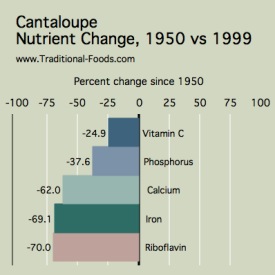 Here on the Iron Rich Food website as we turn over every morsel of food searching for a milligram of iron, history provides us with some disturbing evidence: small garden crops such as spinach have declined in iron on the order of about 15%.
Here on the Iron Rich Food website as we turn over every morsel of food searching for a milligram of iron, history provides us with some disturbing evidence: small garden crops such as spinach have declined in iron on the order of about 15%.
In data collected by the United States Department of Agriculture (USDA), small vegetables and fruit have declined in iron, calcium, phosphorus, riboflavin, vitamin C, and protein since the 1950s.
Scientists began to notice the trend in the 1980s, a trend that has since been examined in published studies, most notably a series of papers out of the University of Texas at Austin. (Read it here.)
Spinach, washed, pre-cut, and bagged at a grocery store is not your grandmother’s spinach and not just because of its plastic zip lock bag. The spinach is less nourishing as well.
 In data housed on the Traditional Foods site, you can explore changes in other foods. Chinese cabbage, cantaloupe, carrots, cauliflower, collard greens, cucumber, honeydew melons, mustard greens, onions, radishes, rhubarb, strawberries, tomato, turnips, and turnip greens all show declines in iron content. These changes in the iron content of individual foods are not statistically significant by themselves but, taken together, they suggest a decline in iron content.
In data housed on the Traditional Foods site, you can explore changes in other foods. Chinese cabbage, cantaloupe, carrots, cauliflower, collard greens, cucumber, honeydew melons, mustard greens, onions, radishes, rhubarb, strawberries, tomato, turnips, and turnip greens all show declines in iron content. These changes in the iron content of individual foods are not statistically significant by themselves but, taken together, they suggest a decline in iron content.
On top of reduced iron, many of these same foods have less vitamin C as well. Vitamin C is an important part of an iron rich diet because it actually helps your body absorb more of the iron in your food. Tomatoes and cantaloupe are popular vitamin C foods and great companions to grain salads and breakfast menus. These popular foods have declined in both iron and vitamin C, making that uphill climb against iron deficiency a bit more strenuous.
Why A Decline? A Trend Toward Commercialized Produce
The most comprehensive study of these data examines possible reasons for the decline in nutritional content of food — soil depletion and changes in the seeds themselves.
Soil depletion is a compelling explanation for the nutrient decline. The idea is that commercial growers have become dependent on fertilizers that focus on nitrogen, phosphorus, and potassium (NPK) rather than the whole spectrum of soil nutrients. This has led to deficient soil. Deficient soil creates deficient vegetables. As a gardener myself, I can certainly see a relationship between the health of our soil and the productivity of the garden. This explanation is compelling but researchers point out that protein (from nitrogen) and phosphorus have both declined in these garden crops even though these nutrients are used in commercial fertilizers.
It appears that blame lies with the cultivation of commercial crop varieties that promote high yield and pest resistant plants. When seeds are cultivated to develop a certain trait in the plant (such as yield), other traits may suffer (such as nutrient content). The authors give the example of Marathon broccoli, the type of broccoli commonly available in stores these days. The broccoli head is much larger than heirloom broccoli but any one head has about the same amount of calcium and iron as an heirloom head of broccoli. The minerals get spread throughout the entire large head, leaving a lower mineral content in any one bite of broccoli. You need to eat more bites to get as much iron as calcium as you would have from grandma’s garden.
Buy Heirloom Produce
 In response to this trend of nutrient decline in produce, one action you can take right now is to find sources of heirloom vegetables, especially vegetables that are staples in your household.
In response to this trend of nutrient decline in produce, one action you can take right now is to find sources of heirloom vegetables, especially vegetables that are staples in your household.
Farmer’s markets are your best bet — simply ask the farmer if the crop is an heirloom. You will find some heirloom items in your local health food store as well. The added benefit is that heirlooms tend to have more flavor and often look a bit more interesting than their commercial counterparts.
Grow Heirloom Produce
Join the growing trend in home gardening and grow your own heirloom fruits and vegetables. On the Traditional Foods site, we have created resources to help you get started in building your soil, composting, buying and saving seed, choosing a location, and knowing your seasons.
Select seed that is open-pollinated, indicated by “OP” on the label. Hybrid seeds are marked F1. Grow your crops is well-composted soil so that the plants will be as prolific as possible and will provide you with nutrient dense produce.